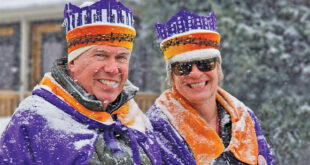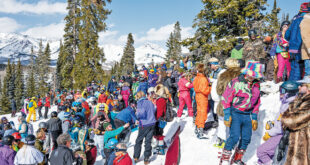A deeper, historical look at how the county handled the pandemic a century ago
By Dr. Duane Vandenbusche
(Editor’s note: We ran into renowned Western Colorado University history professor Dr. Duane Vandenbusche as he was conducting “academic studies” in Kochevar’s last week and asked him to give us the real story of how the county handled the Spanish Flu in 1918. He graciously obliged.)
The Spanish Flu, one of history’s worst epidemics, surpassed all the military deaths in World War I and World War II combined. The best evidence is that it began in the United States in Haskell County, Kansas in the southwest corner of the state. The flu virus mutated quickly, changing so much that the human immune system had a hard time recognizing it and attacking it. A pandemic occurs when a new flu virus that the immune system has not seen comes. That happened in 1918.
The flu was carried to Europe by American soldiers in World War I. It lasted 15 months and was the deadliest disease in human history, killing between 50 million and 100 million people. 670,000 Americans died and of the 25 million Americans who were infected, 20 percent who died were age five and younger. Life expectancy dropped by 12 years and 50 percent of the deaths of U.S. soldiers in the war came from the flu. Victims died within hours of the first symptoms—foamy blood coughed up and then bleeding from the nose, ears and eyes. Towns ran out of coffins and people were buried in mass graves. In many cases coroners died of the flu with dead bodies all around them. Two percent of the world’s population died. In villages in Africa and Alaska everyone died. Six percent of all coal miners died and pregnant women had death rates from 23 percent to 71 percent.
The flu was called Spanish because the Spanish king came down with it and because Spain was the only country to admit that it was a pandemic. An internal American Red Cross report said: “A fear and panic of the flu, akin to the terror of the Middle Ages regarding the Black Plague has been prevalent in many parts of the country.” The first two waves of the flu hit in 1918 and then when many thought it was over, a third wave hit in January 1919. That lasted until the late spring. In Mexico, 3 percent of the entire population died; in Russia and Iran it was 7 percent. In the Fiji Islands 14 percent died in 16 days and one third of the people in Labrador died. Seasonal influenza is bad enough. Over the past four decades it has killed 3,000 to 48,000 Americans annually but the pandemic of 1918-19 was one of the worst disasters in history.
In 10 weeks in the autumn of 1918, 12,000 died in Philadelphia and 20,000 in New York City. The flu brought life to a standstill, emptying city streets, closing churches, pool halls, saloons, and theaters. The Spanish Flu infected the upper respiratory tract and then dived deep into the lungs with viral or bacterial pneumonia. President Woodrow Wilson was unwilling to take any action that would hurt the war effort, even though the disease was sweeping through military bases, killing soldiers and sailors by the thousands. His surgeon general warned against going to the doctor with “mild cases of the flu.”
While the rest of the nation and the world were reeling from the Spanish Flu, Gunnison and Gunnison County stood almost alone as an area that stayed relatively free from the pandemic. On October 18 the board of health closed all schools and churches and banned street gatherings. On November 1, Gunnison was quarantined. Barricades and fences went up on the main highways near town and autos were warned to go through Gunnison at once or submit to quarantine. Anyone trying to do otherwise was arrested and put in jail. Colorado State Normal closed and Chipeta Hall was turned into a detention camp for the mandatory quarantine. Other nearby towns were hit hard by the flu—Silverton lost 10 percent of its population and Salida was not far behind. Hotchkiss had 200 cases of the flu and six dead by late 1918 and Trinidad had 400 cases. Cimarron had 30 cases as late as April 1919.
Quarantine regulations for Gunnison read: “Only leave your homes as absolute necessity requires. Keep your homes well ventilated and admit the sunshine. For the present there shall be no gatherings or meetings of any kind, no services in churches and no lodge meetings. There shall be no schools, either public or private of any number greater than four people. There shall be no theater or place of amusement or entertainment open to the public. Signed, Dr. J.W. Rockefeller.”
A traveler on a train approaching Gunnison in December 1918 declared: “The conductor entered the coach and announced that any person who alighted from the train and even stepped on the platform would be escorted by an officer to quarantine and would be kept there until it was sure there was no influence hanging around and that the usual time was five days.”
The Gunnison public schools were scheduled to open on January 6, 1919 but when the news was announced Dr. Rockefeller, in charge of the quarantine in Gunnison, Crested Butte and the county, resigned. This led Dr. N. Hyat, the health officer, to change his mind and the quarantine stayed on.
Even though Gunnison and Gunnison County were largely immune from the ravages of the Spanish Flu, some did die. Mrs. Cynthia Dice Clifford, who, with her husband Frank, ranched on Quartz Creek, lost her son Elmer to the flu in 1918 and said, “The winter the flu was so bad during the first World War, I remember the doctor visiting half the families in one day along Quartz Creek and then staying overnight to cover the rest of the ranches a second day.”
On October 11, 1918 the Gunnison News Champion headline read “Spanish Flu Close By.” Thirty to 40 cases were in Sargents, said the paper and Colorado Normal held classes outdoors. A week later, a new headline: “The ‘Flu’ Is After Us,” with cases reported in Elko, Parlin and Doyleville.
Then on October 25, “Flu Epidemic Rages Everywhere But Here.” On that day 9,000 cases of the flu were reported in Colorado with 311 dead. On November 4, Ellen Gavette of Parlin died of the flu. She was 25.
On November 15 the News Champion reported: “Gunnison is about the only place in the United States almost free from sickness. We are fortunate, so fortunate that we almost fear it cannot last.” It did not last and 18-year-old Bruce Swan, working for Laurel Spann at Jack’s Cabin, died of the flu a week later. Four days after that Mrs. John Ogden, visiting from Pennsylvania, died at Almont, only 24 years old.
After a brief respite from the flu, in late February the quarantine was lifted. However, in a few weeks the flu reappeared—the third wave. In March 1919 there was a new headline: “Flu Gets Us At Last.” 100 cases appeared in Gunnison, Pitkin, Crested Butte, Sargents and Sapinero.
In mid-March 1919 the News Champion headline screamed: “Grim Hand Of Death Clutches Our Community.” Roy Buck, 22; Romana Outcalt, 29; Ed LeFevre, 33; and Albert Smith, 25 all died from the flu, as did James Dirrem of Pitkin and Frank Bele of Crested Butte. In late March Frank Boson died of the flu; he was 41 and had come from Switzerland. His death was followed by Ray Barnhill of Pitkin.
The Spanish Flu burned itself out by the late spring of 1919. The strict quarantine in the Gunnison country was largely successful with only a few deaths. Colorado, meanwhile had 49,000 cases and 8,000 deaths. With the coronavirus so threatening today, people would do well to remember “back in 1918-19…”
 The Crested Butte News Serving the Gunnison Valley since 1999
The Crested Butte News Serving the Gunnison Valley since 1999



